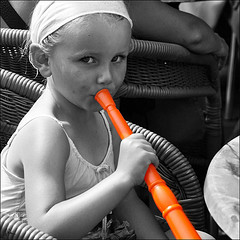Suddenly, a new signal is detected in the noise. It’s still barely audible beneath the enthusiastic din of PLN hoopla, but a crankily skeptical note has been sounded. Too much harmony and joy can’t be healthy, can it? Time to break up the good vibrations with some old-fashioned Schoenbergian dissonance. Let the fistfights erupt in the galleries.
TRUMPET THIS
But first, let’s trot out a tired metaphor that’s already yesterday’s news. Enter the vuvuzela, that horn-shaped stadium noisemaker traditionally used by South African soccer fans, source of the endless televised buzzing that became the soundtrack and symbol of the 2010 FIFA World Cup. O vuvuzela! We celebrate your monotony, your single-minded drone, your undifferentiated ever-presence. Your daddy was a kazoo, your mama was a bugle, and your uncle died of a profound lack of imagination. You buzzed our days and nights like a vengeful mosquito.
Cheap, plastic, disposable: I offer the mighty vuvuzela as handy symbol and signifier of noise in the PLN movement.
Image: Vuvuzela-Loesje
THE FIRST RULE OF FIGHT CLUB
The PLN doesn’t really exist – we all learn from various and organically shifting sources, and contribute likewise. Defining a PLN is overly simplistic. —D’Arcy Norman
My excitement about networked, informal learning and its potential to change absolutely everything absolutely has been tempered lately, my torrid love affair with the PLN dogged by a sense of semantic creep. Seems like you can’t swing a lolcat these days without hitting somebody’s PLN, or somebody talking about their PLN. Not that there’s anything wrong with that. But is there something wrong with that?
We well-meaning humans suffer from the irresistible urge to take complex, idiosyncratic ideas like “personal learning” and boil them down into simple, spreadable packages. Idea-nuggets go down easy, but all the useful roughage is gone. The impulse to bottle it, to capture and replicate and share it, is understandable. Laudable, even. But off the mark. Like many others, I’ve played around with various bottling techniques. Jury’s still out, but I suspect they’re all doomed to some flavor of failure. Jennifer Dalby gets it, and especially gets what it is that’s worth getting:
And I do think it’s important to promote the formal recognition of informal learning. I’d like to see tools developed where we can truly measure professional development and application of new knowledge through open personal PD plans and peer participation and evaluation. I “get” the value of professional and personal networking in online spaces.
I’m concerned that the nascent PLN movement has unconsciously adopted the rhetoric of the self-help movement. I cringe at the thought of this powerful learning engine turned into little more than a glorified self-improvement regimen. The PLN Diet! Grow Your PLN in 10 Easy Steps! Before we know it, our sense of our own learning veers dangerously close to territory already staked out by rock hard abs, slimmer thighs, and a revitalized sex life. By giving it a snappy acronym and reducing it to lists of tips, tools, and steps, we strip informal learning of its mystery, of necessary effort, of personal discomfort, of friction. We gut it, pulling out the bones. We infantilize it. We standardize it, commodify it, package it, put it into a box. We bottle it. We’re only trying to be helpful. This is what educators do. But we have to be careful: the bottled notion/potion we so enthusiastically pass around could be mistaken for Kool-Aid.
Jennifer goes on:
I’ll define the Cult of the PLN as a group of people who’ve turned the PLN concept into a commodity and fetishized it through socialization around it…
That’s fearless and important and worth paying attention to. If personal learning is truly personal, ergo private, ergo mysterious, sacred, inviolable, and inexplicable, what’s a good social constructivist to do? What do we socialize about? The process. About the mystery itself. That’s a song that will always resist being sung by one voice. In edu-discourses great and small, the echo chamber trope crops up like clockwork—usually in the context of a complaint about insularity. Karl Fisch thinks the echo chamber is a myth. He’s a smart guy and probably right, but since we’re wholly committed now to this vuvuzela metaphor, we’ll soldier on. We conjure up the latest incarnation of the echo chamber, and we are surprised to find that it now more closely resembles a soccer stadium: crowded and noisy, vuvuzelas blaring in unanimity, all honking the same note.
Diversifying the echo chamber is a nice idea, but it’s just another recipe, another prescription. By interrogating the language and norms we’ve built up around PLNs, I think Karl and Jennifer have their sights set at bedrock level. What does it all come down to? There are no shortcuts, no easy answers, no skirting meaningful efforts. We learn individually, by doing the personal work of learning, but we can do that in community. We do it by seeking questions more than answers, by embracing the particular and resisting generalization.
Karl shows us the silver lining:
Communities of similarly-minded people, passionate people, working in concert, can accomplish amazing things. We shouldn’t denigrate that, we should celebrate it.
Right. Right. And here’s where my cranky house of cards falls gloriously to pieces and I reveal myself as a softie with a heart of gold. Because here’s the deal: nobody, including me, really cares about my Deep and Serious Litmus Test of Personal Learning Authenticity. Those communities of passionate people working in concert may sound like vuvuzelas—but maybe the rest of us have tin ears. Maybe they’re making beautiful, creative, mysterious, idiosyncratic music. Only they know for sure. Only you know for sure. Only I know for sure.
A PARTING WORD ABOUT BANDWAGONS
Jumping on bandwagons is great exercise. Jumping off again is even better. Steering them is impossible. I realize that this entire polemic about PLN-as-bandwagon is clattering along on wagon wheels of its own, a much smaller rhetorical vehicle going in the not-quite-opposite direction. Must be about time to jump off.
